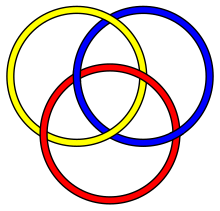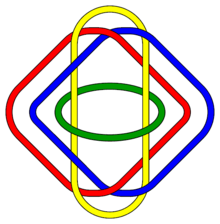Massey product
In algebraic topology, the Massey product is a cohomology operation of higher order introduced in (Massey 1958), which generalizes the cup product. The Massey product was created by William S. Massey, an American algebraic topologist.

Massey triple product
Let be elements of the cohomology algebra of a differential graded algebra . If , the Massey product is a subset of , where .
The Massey product is defined algebraically, by lifting the elements to equivalence classes of elements of , taking the Massey products of these, and then pushing down to cohomology. This may result in a well-defined cohomology class, or may result in indeterminacy.
Define to be . The cohomology class of an element of will be denoted by . The Massey triple product of three cohomology classes is defined by
The Massey product of three cohomology classes is not an element of , but a set of elements of , possibly empty and possibly containing more than one element. If have degrees , then the Massey product has degree , with the coming from the differential .
The Massey product is nonempty if the products and are both exact, in which case all its elements are in the same element of the quotient group
So the Massey product can be regarded as a function defined on triples of classes such that the product of the first or last two is zero, taking values in the above quotient group.
More casually, if the two pairwise products and both vanish in homology (), i.e., and for some chains and , then the triple product vanishes "for two different reasons" — it is the boundary of and (since and because elements of homology are cycles). The bounding chains and have indeterminacy, which disappears when one moves to homology, and since and have the same boundary, subtracting them (the sign convention is to correctly handle the grading) gives a cocycle (the boundary of the difference vanishes), and one thus obtains a well-defined element of cohomology — this step is analogous to defining the st homotopy or homology group in terms of indeterminacy in null-homotopies/null-homologies of n-dimensional maps/chains.
Geometrically, in singular cohomology of a manifold, one can interpret the product dually in terms of bounding manifolds and intersections, following Poincaré duality: dual to cocycles are cycles, often representable as closed manifolds (without boundary), dual to product is intersection, and dual to the subtraction of the bounding products is gluing the two bounding manifolds together along the boundary, obtaining a closed manifold which represents the homology class dual of the Massey product. In reality homology classes of manifolds cannot always be represented by manifolds – a representing cycle may have singularities – but with this caveat the dual picture is correct.
Higher order Massey products
More generally, the n-fold Massey product of n elements of is defined to be the set of elements of the form
for all solutions of the equations
- ,
with and , where denotes .
The higher order Massey product can be thought of as the obstruction to solving the latter system of equations for all , in the sense that it contains the 0 cohomology class if and only if these equations are solvable. This n-fold Massey product is an order cohomology operation, meaning that for it to be nonempty many lower order Massey operations have to contain 0, and moreover the cohomology classes it represents all differ by terms involving lower order operations. The 2-fold Massey product is just the usual cup product and is a first order cohomology operation, and the 3-fold Massey product is the same as the triple Massey product defined above and is a secondary cohomology operation.
J. Peter May (1969) described a further generalization called Matric Massey products, which can be used to describe the differentials of the Eilenberg–Moore spectral sequence.
Applications

The complement of the Borromean rings gives an example where the triple Massey product is defined and non-zero. If u, v, and w are 1-cochains dual to the 3 rings, then the product of any two is a multiple of the corresponding linking number and is therefore zero, while the Massey product of all three elements is non-zero, showing that the Borromean rings are linked. The algebra reflects the geometry: the rings are pairwise unlinked, corresponding to the pairwise (2-fold) products vanishing, but are overall linked, corresponding to the 3-fold product not vanishing.

More generally, n-component Brunnian links – links such that any -component sublink is unlinked, but the overall n-component link is non-trivially linked – correspond to n-fold Massey products, with the unlinking of the -component sublink corresponding to the vanishing of the -fold Massey products, and the overall n-component linking corresponding to the non-vanishing of the n-fold Massey product.
Uehara & Massey (1957) used the Massey triple product to prove that the Whitehead product satisfies the Jacobi identity.
Massey products of higher order appear when computing twisted K-theory by means of the Atiyah–Hirzebruch spectral sequence (AHSS). In particular, if H is the twist 3-class, Atiyah & Segal (2008) showed that, rationally, the higher order differentials in the AHSS acting on a class x are given by the Massey product of p copies of H with a single copy of x.
If a manifold is formal (in the sense of Dennis Sullivan), then all Massey products on the space must vanish; thus, one strategy for showing that a given manifold is not formal is to exhibit a non-trivial Massey product. Here a formal manifold is one whose rational homotopy type can be deduced ("formally") from a finite-dimensional "minimal model" of its de Rham complex. Deligne et al. (1975) showed that compact Kähler manifolds are formal.
Salvatore & Longoni (2005) use a Massey product to show that the homotopy type of the configuration space of two points in a lens space depends non-trivially on the simple homotopy type of the lens space.
See also
References
- Atiyah, Michael; Segal, Graeme (2006), "Twisted K-theory and cohomology", Inspired by S. S. Chern, Nankai Tracts in Mathematics, 11, Hackensack, NJ: World Scientific Publishers, pp. 5–43, arXiv:math.KT/0510674, doi:10.1142/9789812772688_0002, MR 2307274
- Deligne, Pierre; Griffiths, Phillip; Morgan, John; Sullivan, Dennis (1975), "Real homotopy theory of Kähler manifolds", Inventiones Mathematicae, 29 (3): 245–274, Bibcode:1975InMat..29..245D, doi:10.1007/BF01389853, MR 0382702
- Massey, William. S. (1958), "Some higher order cohomology operations", Symposium internacional de topología algebraica (International symposium on algebraic topology), Mexico City: Universidad Nacional Autónoma de México and UNESCO, pp. 145–154, MR 0098366
- May, J. Peter (1969), "Matric Massey products", Journal of Algebra, 12 (4): 533–568, doi:10.1016/0021-8693(69)90027-1, MR 0238929
- McCleary, John (2001), A User's Guide to Spectral Sequences, Cambridge Studies in Advanced Mathematics, 58 (2nd ed.), Cambridge University Press, doi:10.2277/0521567599, ISBN 978-0-521-56759-6, MR 1793722, Chapter 8, "Massey products", pp. 302–304; "Higher order Massey products", pp. 305–310; "Matric Massey products", pp. 311–312
- Salvatore, Paolo; Longoni, Riccardo (2005), "Configuration spaces are not homotopy invariant", Topology, 44 (2): 375–380, arXiv:math/0401075, doi:10.1016/j.top.2004.11.002, MR 2114713
- Uehara, Hiroshi; Massey, William S. (1957), "The Jacobi identity for Whitehead products", Algebraic geometry and topology. A symposium in honor of S. Lefschetz, Princeton, N.J.: Princeton University Press, pp. 361–377, MR 0091473